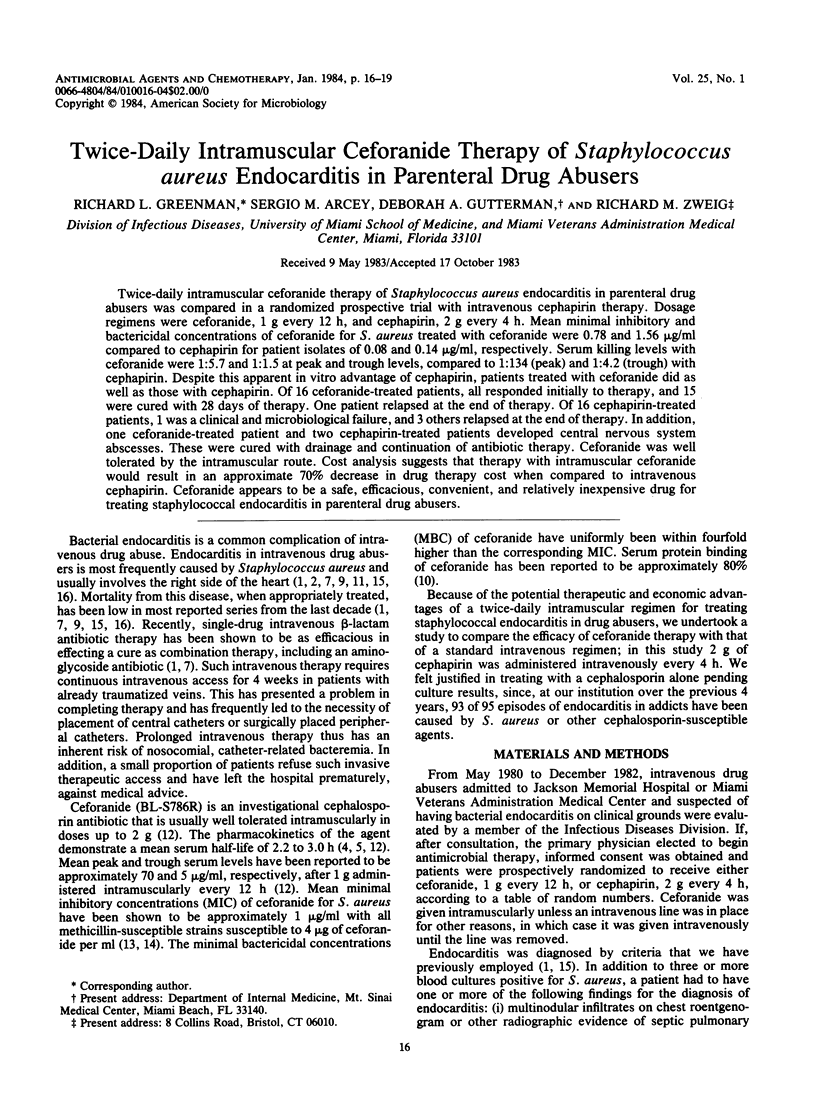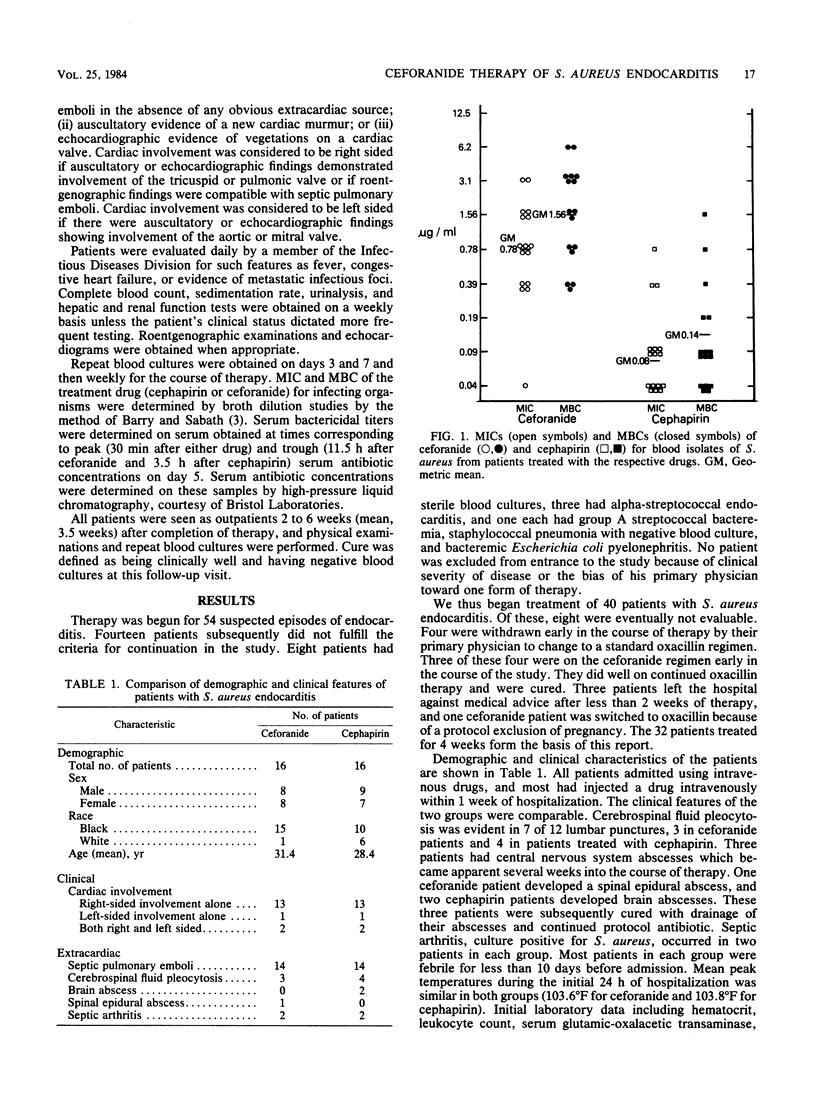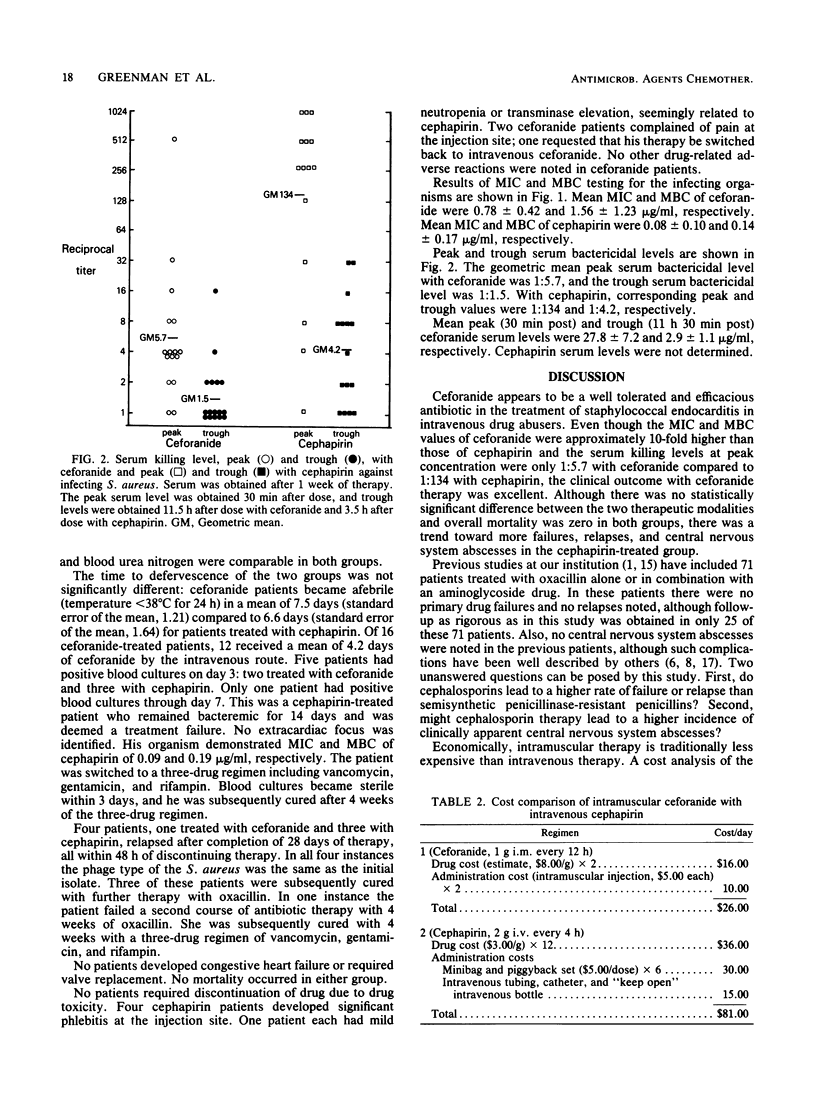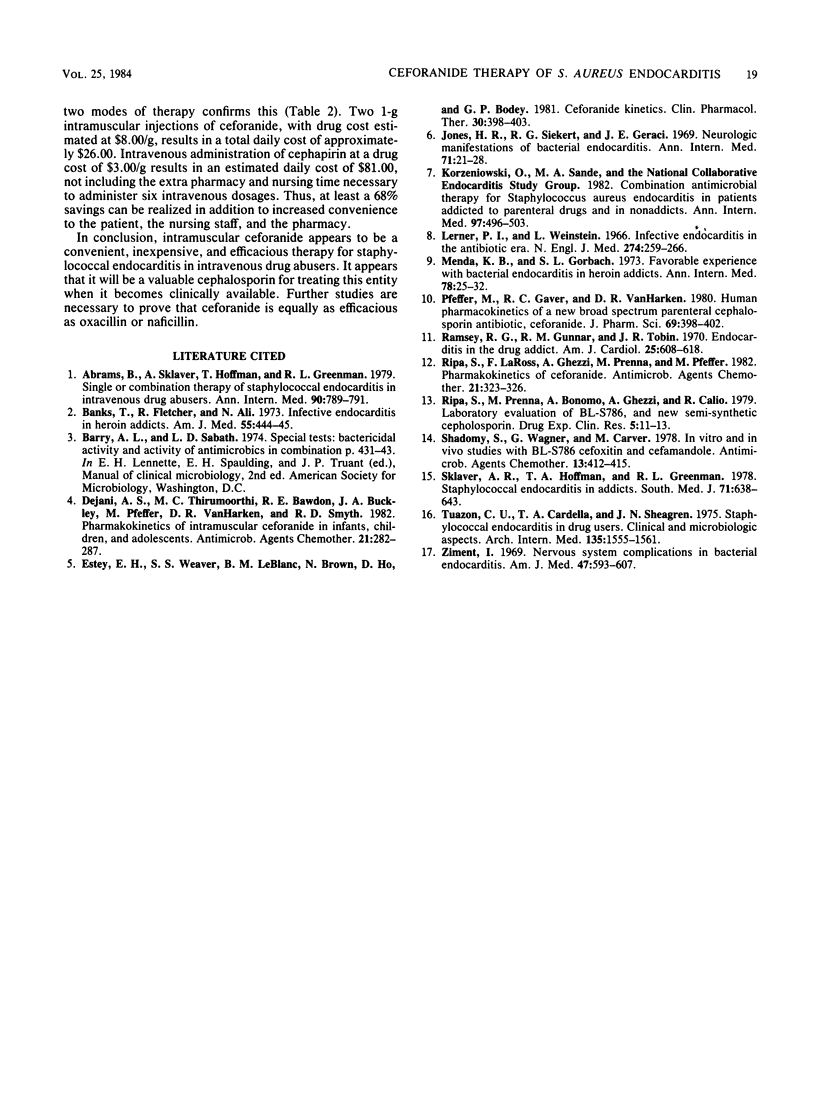Abstract
Twice-daily intramuscular ceforanide therapy of Staphylococcus aureus endocarditis in parenteral drug abusers was compared in a randomized prospective trial with intravenous cephapirin therapy. Dosage regimens were ceforanide, 1 g every 12 h, and cephapirin, 2 g every 4 h. Mean minimal inhibitory and bactericidal concentrations of ceforanide for S. aureus treated with ceforanide were 0.78 and 1.56 microgram/ml compared to cephapirin for patient isolates of 0.08 and 0.14 microgram/ml, respectively. Serum killing levels with ceforanide were 1:5.7 and 1:1.5 at peak and trough levels, compared to 1:134 (peak) and 1:4.2 (trough) with cephapirin. Despite this apparent in vitro advantage of cephapirin, patients treated with ceforanide did as well as those with cephapirin. Of 16 ceforanide-treated patients, all responded initially to therapy, and 15 were cured with 28 days of therapy. One patient relapsed at the end of therapy. Of 16 cephapirin-treated patients, 1 was a clinical and microbiological failure, and 3 other relapsed at the end of therapy. In addition, one ceforanide-treated patient and two cephapirin-treated patients developed central nervous system abscesses. These were cured with drainage and continuation of antibiotic therapy. Ceforanide was well tolerated by the intramuscular route. Cost analysis suggests that therapy with intramuscular ceforanide would result in an approximate 70% decrease in drug therapy cost when compared to intravenous cephapirin. Ceforanide appears to be a safe, efficacious, convenient, and relatively inexpensive drug for treating staphylococcal endocarditis in parenteral drug abusers.
Full text
PDF



Selected References
These references are in PubMed. This may not be the complete list of references from this article.
- Abrams B., Sklaver A., Hoffman T., Greenman R. Single or combination therapy of staphylococcal endocarditis in intravenous drug abusers. Ann Intern Med. 1979 May;90(5):789–791. doi: 10.7326/0003-4819-90-5-789. [DOI] [PubMed] [Google Scholar]
- Banks T., Fletcher R., Ali N. Infective endocarditis in heroin addicts. Am J Med. 1973 Oct;55(3):444–451. doi: 10.1016/0002-9343(73)90201-5. [DOI] [PubMed] [Google Scholar]
- Dajani A. S., Thirumoorthi M. C., Bawdon R. E., Buckley J. A., Pfeffer M., Van Harken D. R., Smyth R. D. Pharmacokinetics of intramuscular ceforanide in infants, children, and adolescents. Antimicrob Agents Chemother. 1982 Feb;21(2):282–287. doi: 10.1128/aac.21.2.282. [DOI] [PMC free article] [PubMed] [Google Scholar]
- Estey E. H., Weaver S. S., LeBlanc B. M., Brown N., Ho D. H., Bodey G. P. Ceforanide kinetics. Clin Pharmacol Ther. 1981 Sep;30(3):396–403. [PubMed] [Google Scholar]
- Jones H. R., Jr, Siekert R. G., Geraci J. E. Neurologic manifestations of bacterial endocarditis. Ann Intern Med. 1969 Jul;71(1):21–28. doi: 10.7326/0003-4819-71-1-21. [DOI] [PubMed] [Google Scholar]
- Korzeniowski O., Sande M. A. Combination antimicrobial therapy for Staphylococcus aureus endocarditis in patients addicted to parenteral drugs and in nonaddicts: A prospective study. Ann Intern Med. 1982 Oct;97(4):496–503. doi: 10.7326/0003-4819-97-4-496. [DOI] [PubMed] [Google Scholar]
- Lerner P. I., Weinstein L. Infective endocarditis in the antibiotic era. N Engl J Med. 1966 Feb 3;274(5):259–contd. doi: 10.1056/NEJM196602032740506. [DOI] [PubMed] [Google Scholar]
- Menda K. B., Gorbach S. L. Favorable experience with bacterial endocarditis in heroin addicts. Ann Intern Med. 1973 Jan;78(1):25–32. doi: 10.7326/0003-4819-78-1-25. [DOI] [PubMed] [Google Scholar]
- Pfeffer M., Gaver R. C., Van Harken D. R. Human pharmacokinetics of a new braod-spectrum parenteral cephalosporin antibiotic, ceforanide. J Pharm Sci. 1980 Apr;69(4):398–403. doi: 10.1002/jps.2600690409. [DOI] [PubMed] [Google Scholar]
- Ramsey R. G., Gunnar R. M., Tobin J. R., Jr Endocarditis in the drug addict. Am J Cardiol. 1970 May;25(5):608–618. doi: 10.1016/0002-9149(70)90600-4. [DOI] [PubMed] [Google Scholar]
- Ripa S., La Rosa F., Ghezzi A., Prenna M., Pfeffer M. Pharmacokinetics of ceforanide. Antimicrob Agents Chemother. 1982 Feb;21(2):323–326. doi: 10.1128/aac.21.2.323. [DOI] [PMC free article] [PubMed] [Google Scholar]
- Shadomy S., Wagner G., Carver M. In vitro and in vivo studies with BL-S786, cefoxitin, and cefamandole. Antimicrob Agents Chemother. 1978 Mar;13(3):412–415. doi: 10.1128/aac.13.3.412. [DOI] [PMC free article] [PubMed] [Google Scholar]
- Sklaver A. R., Hoffman T. A., Greenman R. L. Staphylococcal endocarditis in addicts. South Med J. 1978 Jun;71(6):638–643. doi: 10.1097/00007611-197806000-00009. [DOI] [PubMed] [Google Scholar]
- Tuazon C. U., Cardella T. A., Sheagren J. N. Staphylococcal endocarditis in drug users. Clinical and microbiologic aspects. Arch Intern Med. 1975 Dec;135(12):1555–1561. [PubMed] [Google Scholar]
- Ziment I. Nervous system complications in bacterial endocarditis. Am J Med. 1969 Oct;47(4):593–607. doi: 10.1016/0002-9343(69)90189-2. [DOI] [PubMed] [Google Scholar]


